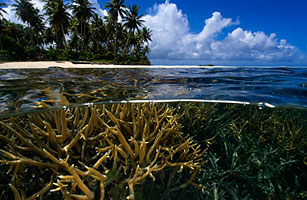
Imagine a protected park half the size of the continental U.S., covering a sea-life-loaded swath of the Pacific Ocean and the 607 tropical islands therein. The park’s inhabitants live mostly in traditional villages and still remember how to do things much of the world has forgotten, such as make clothes from scratch and live off the land. This park would, in fact, encompass an entire country — the Federated States of Micronesia — and if the archipelago nation pulls it off, it will be the first of its kind in the world. “It’s a visionary, radical concept,” says Howard Rice, an instructor at the College of Micronesia who came up with the idea. “There’s never been a world park. It doesn’t exist in the dictionary. It doesn’t exist anywhere.”
If successful, Micronesia will be the first nation to become a wholly protected area, adhering to development and conservation standards designed to safeguard the country’s unique culture and rich marine biodiversity and kick-start its placid economy. According to Rice, who once operated an eco-tourism company in the Caribbean, developing high-end eco-tourism is the answer to F.S.M.’s perennial job shortage. Michigan State University has already agreed to provide technical expertise for the park, and the National Geographic Society has also issued the project its stamp of approval. This spring, Pohnpei, one of F.S.M.’s four states, will host an economic summit to address the park’s planning.
There are hurdles. Although the state of Pohnpei is spearheading the effort to move the project forward, its development-hungry governor has proposed building a casino and resort complex “of not less than 1,000 rooms” — not exactly a conservation-minded move. In fact, even though the world-park concept was first floated in 2004, no guidelines for development in the park have been drawn yet, bringing into question how valuable the project will really be in conservation terms. The national government, too, remains skeptical. “It might be a workable idea,” says Joseph Urusemal, a senator who was President when the world-park concept was introduced. “We just couldn’t get a good grip on what it was going to be, how much it would cost and what would be the benefit.”
The local conservation community also sees the world park as a straight-up tourism initiative backed by foreign researchers out of touch with local values. Though there are state governments, Micronesia’s limited land — all 607 small islands comprise only 271 square miles in total — is mostly controlled by family clans, and setting even small patches of it aside has proved problematic in the past. In the early 1990s, the U.S.-based Nature Conservancy tried to survey land in Pohnpei for a proposed watershed-management plan. “We almost got macheted to death,” says Bill Raynor, who moved to Pohnpei from California 30 years ago and helped establish the Conservancy’s presence in Micronesia. “None of us wants to walk out to the communities with a finished plan produced by university experts. That’s not the way to go here in Micronesia.”
The park’s advocates argue that the project is a work in progress. Nothing will be finalized without consulting the communities, says Richard Paulsen, a recreation- and resource-studies expert at MSU. “Our complete intention is that this be a Micronesian concept,” he says. “This is something that the person on the street must understand, accept and be able to live with.”
The larger question — whether an entire country can declare itself a park without the support of an international conservation body — has, in a way, been answered. “If the government wants to do it, they can do it,” says Peter Shadie of the International Union for Conservation of Nature. But that doesn’t mean the park would fit his organization’s definition of a protected area, which emphasizes the long-term conservation of nature and its associated ecosystem services and cultural values. “The definition [of protected area] has a lot of latitude,” says Shadie. “At the end of the day, it is a class of land use purposely set aside for conservation, rather than a class of land use designed for people to live in.”
By definition, though, the world park would envelop both people and their property, a factor that is a concern to many Micronesians. They worry that the initiative might cast their country as some sort of zoo: a place for travelers to gawk at a culture locked in the past. And just how landowners will react to having rules imposed on them by the central government remains to be seen. “Ownership here is very, very tight,” says John Haglelgam, who served as President of F.S.M. from 1987 to 1991 and is now a history professor at the College of Micronesia. “The world park goes to the core of the land-ownership system.”
The park could be an answer to the question that has plagued Micronesia’s leaders for decades: how to achieve economic development while maintaining F.S.M.’s culture. Politicians worry the country will suffer the same fate as its island neighbor Guam, home to high-rise hotels and a traditional culture in shards. But Guam also offers opportunity, and some 2,000 F.S.M. residents migrate out of the country each year both to Guam and the U.S. seeking education and employment.
Is pinning the nation’s future on a flock of eco-tourists realistic? Many say no. “F.S.M. is in economic desperation,” says Haglelgam. “But I don’t think this is the magic bullet.”
See the best pictures of 2009.